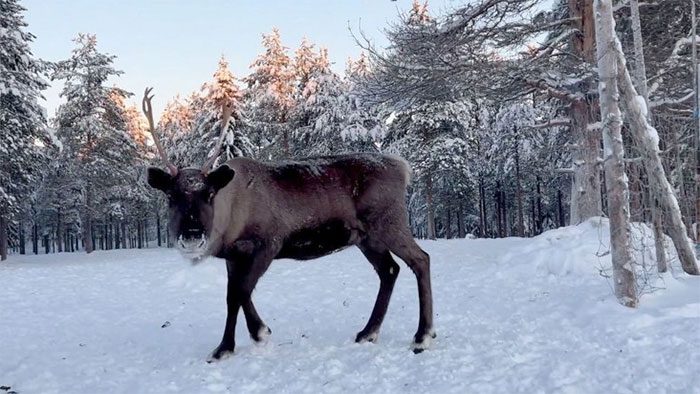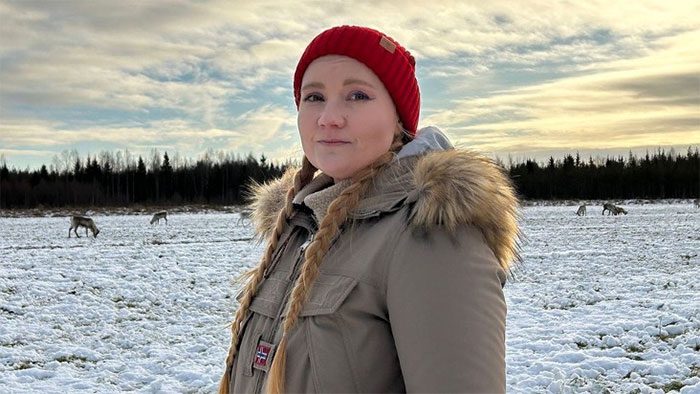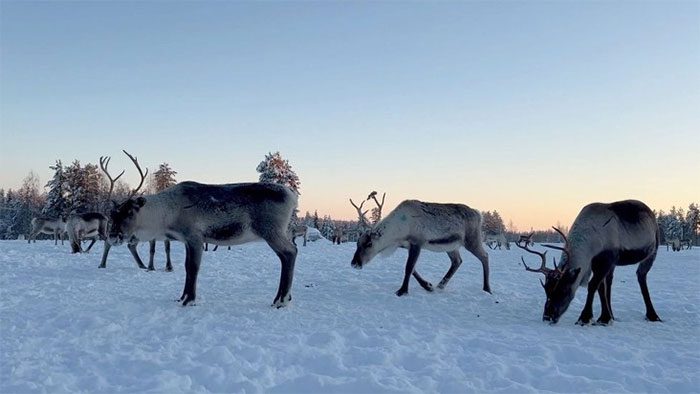Every cold winter season, reindeer in Lapland (Finland) are assigned a vital task: to graze on shrubs that retain heat, helping to slow down global warming.
According to BBC, just after lunch, darkness fell over the snowy land of Lapland. Tiina Jeremejeff, a reindeer herder in northern Finland, quickly jumped on her snowmobile to feed her family’s herd. These animals are kept in large enclosures during the winter. Amid the biting cold, Jeremejeff’s breath almost froze. The temperature in Kierinki, located just 110 km north of the Arctic Circle, has dropped to -15°C. In the forest, a thick layer of snow about 20 cm deep has covered the entire landscape.

Reindeer herding is the livelihood of more than 20 different indigenous communities in the Arctic. (Photo: BBC)
“Being a reindeer herder is not easy. The harsh climate means we have to go out to feed them no matter how cold it gets,” Jeremejeff, a Sami woman, shared.
The Sami culture is closely tied to reindeer herding, and their livelihoods primarily depend on these animals.
Now, evidence suggests that reindeer can play a crucial role in preserving this entire ecosystem — including the snow cover, sparse forests with low-growing shrubs, moss, and lichens (organisms formed by the close association of fungi and algae) — and even the cold winter climate. Research shows that reindeer grazing can actually help mitigate some impacts of climate change in the Arctic, which is warming four times faster than the rest of the planet.
Reindeer herding is the livelihood of more than 20 different indigenous communities in the Arctic. Approximately 100,000 residents are herding about 2.5 million domesticated reindeer across 9 countries.
Historically, indigenous communities have used reindeer for transportation, their hides for clothing, and they are also considered a food source. During the warmer months, reindeer are allowed to roam and graze on lichens and other plants, trampling the ground as they move. In this process, they prevent the growth of woody shrubs.

Tiina Jeremejeff, a reindeer herder in Lapland. (Photo: BBC)
In the frigid Lapland region, “shrub encroachment” has become a complex issue. Shrubs can “erase” ancient ecosystems characterized by sparse forests, known as boreal forests, and treeless Arctic tundra. Shrubs can also exacerbate the effects of climate change, as they retain heat that melts permafrost and warms the tundra.
Global warming is indeed accelerating the process of shrub encroachment in the Arctic. A longer, warmer growing season will speed up plant growth. This can lead to a cycle with more shrubs, retaining more heat. Fortunately, reindeer have become “warriors” that can help slow this process and green the tundra by grazing on and trampling this vegetation.
Research analyzing satellite images of shrub cover on the Yamal Peninsula in northwestern Siberia shows that vegetation in the area remained stable as reindeer numbers increased by 75% from 1986 to 2016, despite rising summer temperatures.
The authors of the report state that reindeer herding on the Yamal Peninsula seems to have offset the impacts of climate change. Reindeer also help preserve tundra habitats, allowing native species like moss, lichens, and low-growing willows to continue thriving.
Jeremejeff and other reindeer herders in Lapland have witnessed this firsthand.
She said: “Reindeer eat lichens and other plants. They also trample vegetation to ensure that the plant cover doesn’t become too dense, which cools the ground. Thick vegetation on the ground retains a lot of heat. Without leaves and grass, the ground will freeze more and freeze earlier in winter.”
Tiina Sanila-Aikio is also a Sami reindeer herder and a former chair of the Sami Council in the Finnish Parliament.
Aikio’s reindeer roam year-round in the forests around Lake Inari in northern Finland. She believes that reindeer herding is a solution to maintain ecology in both the tundra and boreal forests, despite the challenges posed by climate change.
“The forests here are quite vast and sparse. That’s thanks to the reindeer. Without them, the landscape would be completely different. As it gets warmer, all species grow much faster. We need reindeer to keep the forests wide and sparse,” Aikio stated.
The way reindeer consume vegetation also affects the heat-reflecting ability of snow and ice. Research indicates that shrubs accelerate the melting of snow and ice in spring, as they retain heat and generate warmth through their dark branches rising above the snow. By removing shrubs, reindeer can help slow down the melting process, preserving snow cover and its cooling effect, reflecting sunlight. Researchers suggest this could be especially important in tundra areas where there is no tree cover.

Reindeer help slow down global warming. (Photo: BBC)
However, climate change has posed serious challenges to reindeer herding in recent years. Thick and hard snow has worsened grazing conditions as the ice traps lichens, the primary food source for reindeer in winter. Reindeer also cannot dig through the hard ice layer to find food.
To counter this issue, some herders, including Jeremejeff’s family, have started to enclose areas to feed reindeer in winter. This way, they can easily provide supplementary food like hay and pellets to the reindeer.
However, if reindeer are confined for too long, it could be bad news for the climate. Research shows that free-roaming reindeer, trampling vegetation, have a powerful effect in preventing shrub encroachment and warming the surface.
The Sami also believe that maintaining reindeer grazing is essential for sustaining the balance of the natural environment.
“Nature is everything to the Sami, and we respect that deeply. We take resources from nature: picking berries, fishing, and harvesting reindeer meat. But we cannot just take; we must also give back to nature,” Sanila-Aikio said.



















































